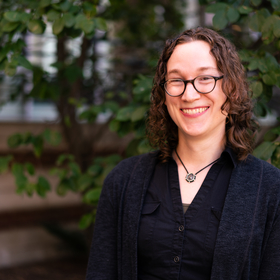

United States
Molecular and Cellular Biology
420 Washington Ave SE
Minneapolis, MN 55455
United States
Lexy
von Diezmann
Our lab studies how proteins self-organize and pattern cells from a quantitative, interdisciplinary perspective. We focus on how crossover repair is coordinated during meiosis in the model organism C. elegans.
Research statement
Faithful transmission of genetic material to one’s progeny is a necessity for all eukaryotes, and cells have evolved sophisticated strategies to avoid propagating DNA damage. Yet for parental chromosomes to partition evenly during meiotic cell division, they must first be broken and recombined. Such physical and genetic exchanges, or crossovers, drive evolution and are necessary to produce gametes (spores, eggs, sperm) with a complete set of chromosomes. Accordingly, the number of crossovers formed on each pair of chromosomes is tightly regulated. Yet while the genetic phenomenon of “interference” between nascent crossovers on the same chromosome was first observed in 1913, we are still working to understand the signaling mechanisms that coordinate meiotic DNA repair events up to megabases apart.
The Diezmann lab uses single-molecule fluorescence microscopy and genome engineering to reverse-engineer the dynamic chemical system underlying crossover repair outcomes. We primarily work in the germline of the transparent, genetically tractable model organism C. elegans. By resolving protein motion in the developing meiotic nuclei of this tiny animal, our work provides a window into the nanoscale molecular biology of transformative DNA repair.
We aim to answer questions such as:
How does the liquid-like protein bilayer at the 100 nm thick interface of meiotic chromosomes act as a scaffold for DNA repair?
What are the roles of scaffolded (1D) vs. nucleoplasmic (3D) diffusion in communicating the progress of the crossover repair pathway?
What factors and conditions are sufficient to designate a given DNA break for crossover repair?
Because of its fundamental nature, our research on how cells regulate and direct DNA repair fate aims to support a range of applications including human fertility, plant breeding, and cancer therapy.
Selected publications
LvD, O. Rog, ‘Single-Molecule Tracking of Chromatin-Associated Proteins in the C. elegans Gonad,’ J. Phys. Chem. B 125, 6162-6170 (2021) [https://pubs.acs.org/doi/10.1021/acs.jpcb.1c03040]
LvD, O. Rog, ‘Let’s get physical: Mechanisms of crossover regulation,’ J. Cell Sci., 134, 1-12 (2021). [https://journals.biologists.com/jcs/article/134/10/jcs255745/268335/Let-s-get-physical-mechanisms-of-crossover]
LvD, Y. Shechtman, W.E. Moerner, ‘Three-dimensional localization of single molecules for super-resolution imaging and single-particle tracking,’ Chem. Rev., 117, 7244 (2017). [https://pubs.acs.org/doi/10.1021/acs.chemrev.6b00629]
Education and background
Education
- 2018-2023 Fellow, Center for Cell and Genome Science, University of Utah, SLC UT
- 2011-2018 PhD, Chemical Physics, Stanford University, Stanford CA
- 2007-2011 BA, Chemistry, Reed College, Portland OR
Selected awards
- 2023-2025 Dale F. Frey award for Breakthrough Scientists, Damon Runyon Cancer Research Foundation
- 2021-present Leading Edge Fellow
- 2019-2023 Mark Foundation Fellow of the Damon Runyon Cancer Research Foundation